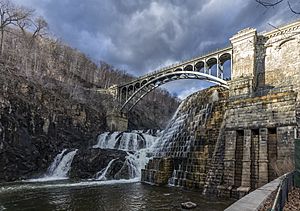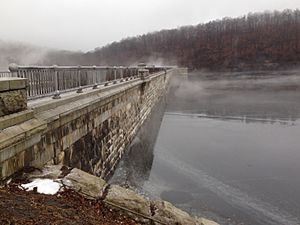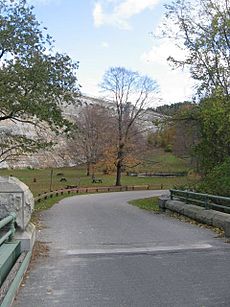New Croton Dam facts for kids
Quick facts for kids New Croton Dam |
|
|---|---|

New Croton Dam in 2016
|
|
| Location | Cortlandt, Westchester County, New York, USA |
| Coordinates | 41°13′35″N 73°51′19″W / 41.22639°N 73.85528°W |
| Construction began | 1892 |
| Opening date | 1906 |
| Operator(s) | New York City |
| Dam and spillways | |
| Height | 297 feet (91 m) |
| Length | 2,188 feet (667 m) |
| Width (base) | 266 feet (81 m) |
| Reservoir | |
| Creates | New Croton Reservoir |
The New Croton Dam is a huge wall that holds back water to create the New Croton Reservoir. Both the dam and the reservoir are important parts of the New York City water supply system. This amazing structure is built across the Croton River near Croton-on-Hudson, New York. It's about 22 miles (35 km) north of New York City.
Building the dam started in 1892 and finished in 1906. It was designed by Alphonse Fteley. The dam is made of stone and is 266 feet (81 m) wide at its bottom. It stands 297 feet (91 m) tall from its base to the very top. When it was completed, it was the tallest dam in the world! It can hold about 19 billion US gallons (72,000,000 m3) of water. This is a small part of New York City's total water storage, which is 580 billion US gallons (2.2×109 m3).
Contents
The Story of the New Croton Dam
Why a New Dam Was Needed
New York City needed more water as it grew. So, an older dam, called the Old Croton Dam, was built between 1837 and 1842. This dam was 50 feet (15 m) high. By 1881, it could supply about 90 million US gallons (340,000 m3) of water each day to the city. The water traveled through the Old Croton Aqueduct.
But the city kept growing and needed even more water. In 1885, officials decided to build a brand new Croton water system. They hired a water engineer named James B. Francis to help plan the huge project.
The new dam and reservoir would cover a large area, about 20 square miles (52 km2). This land had many buildings, farms, and even cemeteries. There were some disagreements and lawsuits about buying the land. But eventually, the land was bought, and construction could begin. Many of the stonemasons and workers who built the first dam also worked on this new one. Some skilled stonemasons even came from southern Italy to help.
How the Dam Was Built
Building the dam was a massive job. Workers had to change the river's path and dry out the riverbed. They dug a curved canal, 1,000 feet (300 m) long and 200 feet (61 m) wide, on the north side of the river. They also built temporary dams to control the water.
The main construction took eight years. More work and repairs continued for another six years. Working conditions were often very tough. There was even a silent movie made in 1900 called The Croton Dam Strike. It showed some of the problems between workers and managers during the dam's construction.
The dam's foundation goes 130 feet (40 m) deep below the riverbed. The dam itself contains 850,000 cubic yards (650,000 m3) of stone. A special plaque on the dam says the spillway (where extra water flows over) is 1,000 feet (300 m) long. The total length of the dam and spillway together is 2,188 feet (667 m).
Work started in 1892, a few miles downstream from the old dam. The old dam was eventually covered by the new reservoir. The New Croton Reservoir can now supply 200 to 300 million US gallons (760,000 to 1,140,000 m3) of water each day. This water travels through a new aqueduct to Jerome Park Reservoir in New York City.
Keeping the Dam Safe
The bridge that goes over the spillway was replaced in 1975 and again in 2005. After the events of September 11, 2001, in New York City, the city's water department decided to close the road across the top of the dam permanently for safety. Only people walking and emergency vehicles are allowed to use New Croton Dam Road. All other cars have to take a different route. The department also planned to put in permanent barriers after a big repair project finished in 2011.
Exploring the Area Around the Dam
You can visit Croton Gorge Park to get great views of the dam from below. The Old Croton Trail is a popular path for hiking and biking. It follows the route of the Old Croton Aqueduct and ends near the dam. Other nature spots nearby include Teatown Lake Reservation and Croton Point Park.
- Historic American Engineering Record (HAER) No. NY-132, "New Croton Dam & Reservoir, Croton River, Croton-on-Hudson vicinity, Westchester County, NY"
Images for kids
-
The scene at Croton Dam spillway after Hurricane Ida in 2021






